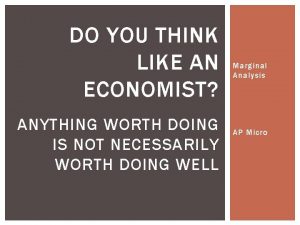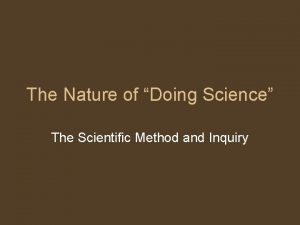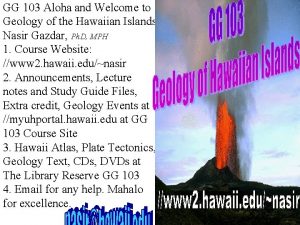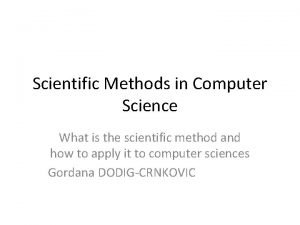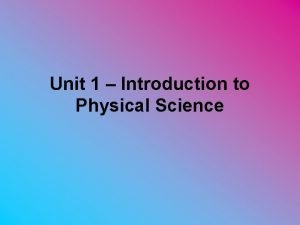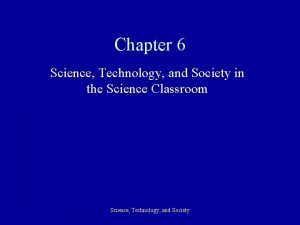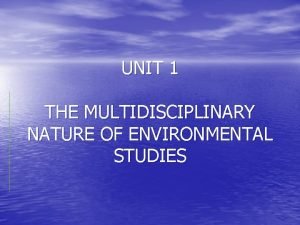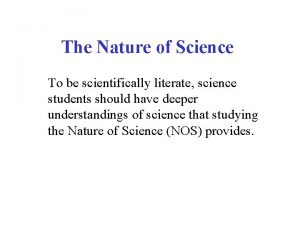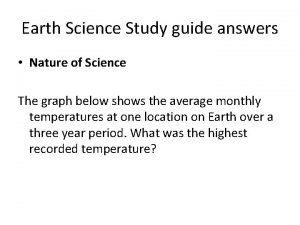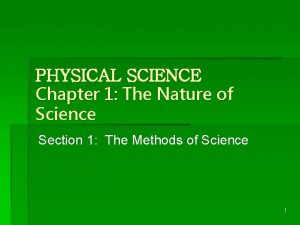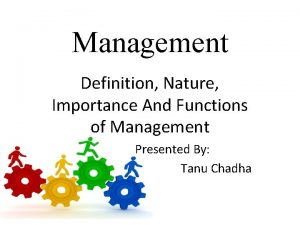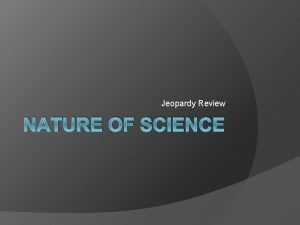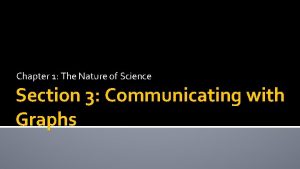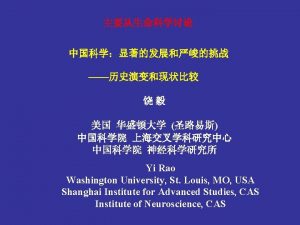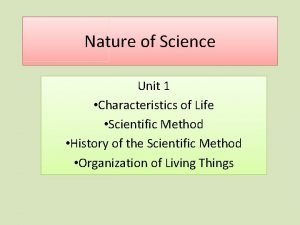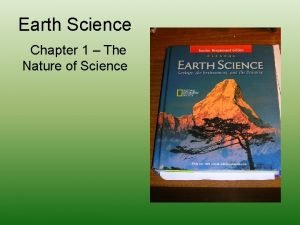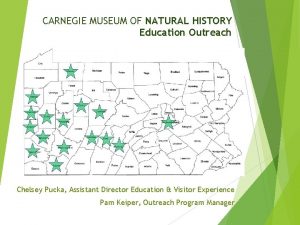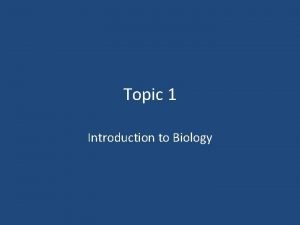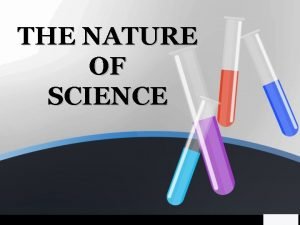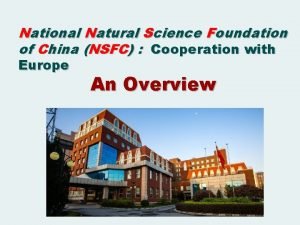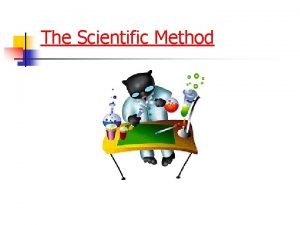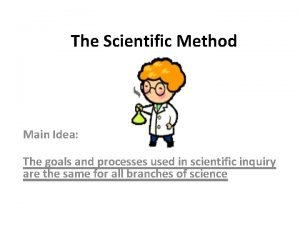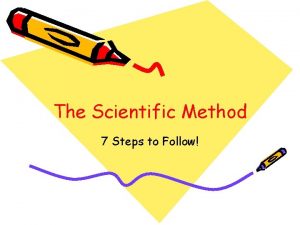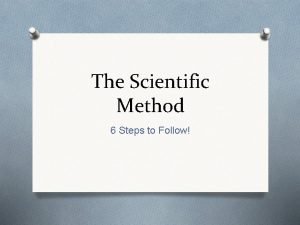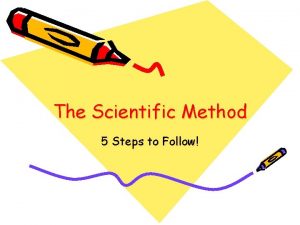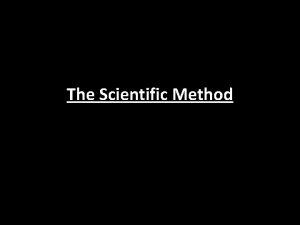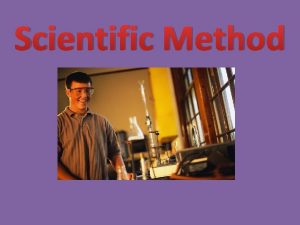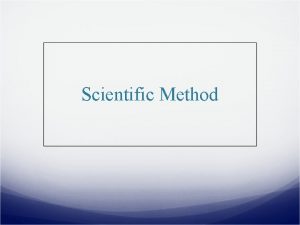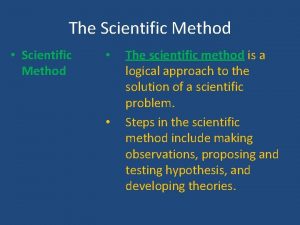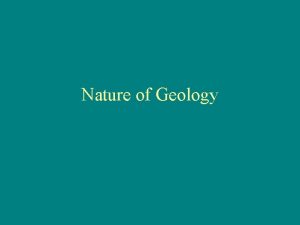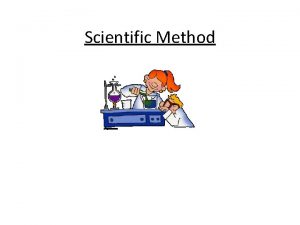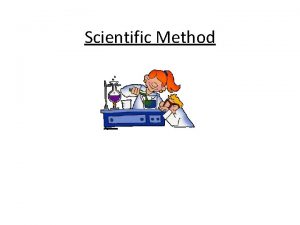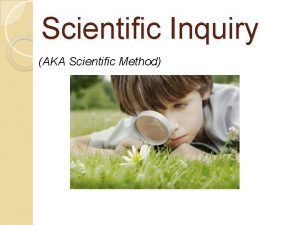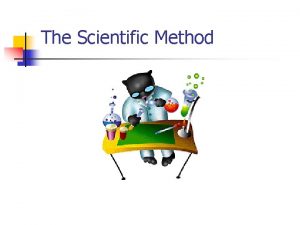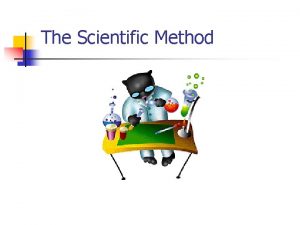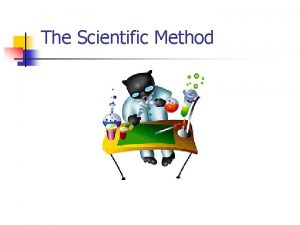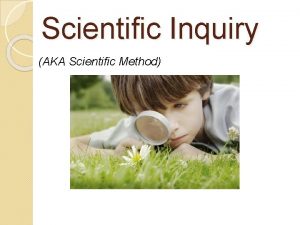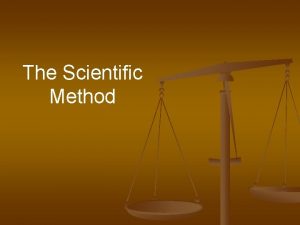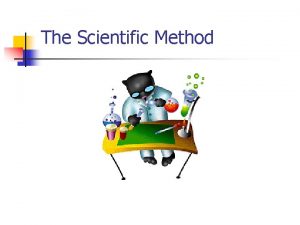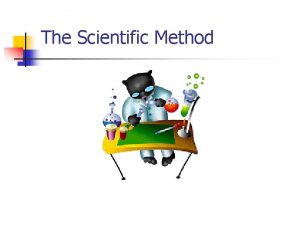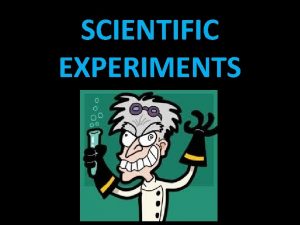The Nature of Doing Science The Scientific Method





































- Slides: 37

The Nature of “Doing Science” The Scientific Method and Inquiry

Two main forms of inquiry in the study of nature • The word Science is derived from Latin and means “to know” • is the search for information and explanation • There are two main types of scientific inquiry: • •

Discovery Science • Discovery science describes • This approach is based on observation and the analysis of data

Types of Data • Data are recorded observations or items of information • Data fall into two categories – , or descriptions rather than measurements – , or recorded measurements, which are sometimes organized into tables and graphs Copyright © 2008 Pearson Education, Inc. , publishing as Pearson Benjamin Cummings

Fig. 1 -23

Induction in Discovery Science • Inductive reasoning • Repeat specific observations can lead to important generalizations – For example, “the sun always rises in the east” Copyright © 2008 Pearson Education, Inc. , publishing as Pearson Benjamin Cummings

Hypothesis-Based Science • Observations can lead us to ask questions and propose hypothetical explanations called hypotheses • A hypothesis is a tentative answer to a wellframed question • A scientific hypothesis leads to predictions that can be tested by observation or experimentation

• For example, – Observation: Your flashlight doesn’t work – Question: Why doesn’t your flashlight work? – Hypothesis 1: The batteries are dead – Hypothesis 2: The bulb is burnt out • Both these hypotheses are testable Copyright © 2008 Pearson Education, Inc. , publishing as Pearson Benjamin Cummings

Deduction: The “If…Then” Logic of Hypothesis Based Science • uses general premises to make specific predictions • For example, if organisms are made of cells (premise 1), and humans are organisms (premise 2), then humans are composed of cells (deductive prediction) Copyright © 2008 Pearson Education, Inc. , publishing as Pearson Benjamin Cummings

A Closer Look at Hypotheses in Scientific Inquiry • A hypothesis must be testable and falsifiable • Hypothesis-based science often makes use of two or more alternative hypotheses • Failure to falsify a hypothesis does not prove that hypothesis – For example, you replace your flashlight bulb, and it now works; this supports the hypothesis that your bulb was burnt out, but does not prove it (perhaps the first bulb was inserted incorrectly) Copyright © 2008 Pearson Education, Inc. , publishing as Pearson Benjamin Cummings

The Scientific Method • 7 steps of the scientific method 1. 2. Statement of the problem 3. 4. Design an experiment 5. 6. 7.

Observation May be the most important step. Before you can really do anything, you must first notice that something needs to be done. Observation is really recognizing a discrepancy. E. O. Wilson

Statement of the problem • Always written as a “what” question. – What is the effect of increased temperature on cricket chirps? – What is the effect of increased speed on fuel consumption? • Stating the observed discrepancy in the manner of a question allows one to develop an answer. • What questions lead to a cause and effect. “Why” questions can be answered with a simple “because”.

Hypothesis • Defined as an educated guess • The hypothesis is what you think is the best answer to the question you posed when you stated the problem. • Best when written in a cause and effect manner. • When developing a hypothesis, always keep in mind the original observation, and the problem that you are trying to answer.

Design an experiment • Experiment- is carefully designed to test a specific hypothesis which addresses a particular problem. • What are some things to think about when designing an Experiment?

Things to think about when designing an experiment • •

Parts of an experiment • Control: Aspect of the experiment that is held constant so as to have a standard of comparison. • Independent variable: • Dependent variable: • The dependent variable depends on the independent variable

Experiment (continued) • Control group: part of the experiment that is used as a control. • Constant: factor that does not change throughout experiment • Experimental group: group with in the experiment which all things are the same as the control group except for one aspect, which is referred to as the variable. Plan an experiment investigating mealworm behavior.

Collect and analyze data • After the experiment has been conducted, data must be collected analyzed. Things to think about: Is the data numerical Is it descriptive Are there any statistics that I can use to summarize the information?

Draw Conclusions are judgments based on an experience and the interpretation of data. Conclusions can be different. We all have different experience Some conclusions are better than others. The difference between a good biologist and an average biologist may be the ability to draw relevant conclusions

Report findings • In the field of Biological research this entails writing papers • Basically you are responsible for informing the community of your results • You recognized a gap in our knowledge about the world around us. Once you know the information you need to tell the public so as to fill the gap. • That means being able to properly communicate

The cyclical nature of science • If your hypothesis is not proven correct by your experiment you must reject it, and draw whatever conclusions that you can then develop a new hypothesis and experiment.

The Myth of the Scientific Method • The scientific method is an idealized process of inquiry • Hypothesis-based science is based on the “textbook” scientific method but rarely follows all the ordered steps • Discovery science has made important contributions with very little dependence on the so-called scientific method Copyright © 2008 Pearson Education, Inc. , publishing as Pearson Benjamin Cummings

A Case Study in Scientific Inquiry: Investigating Mimicry in Snake Populations • Many poisonous species are brightly colored, which warns potential predators • Mimics are harmless species that closely resemble poisonous species • Henry Bates hypothesized that this mimicry evolved in harmless species as an evolutionary adaptation that reduces their chances of being eaten Copyright © 2008 Pearson Education, Inc. , publishing as Pearson Benjamin Cummings

• This hypothesis was tested with the poisonous eastern coral snake and its mimic the nonpoisonous scarlet kingsnake • Both species live in the Carolinas, but the kingsnake is also found in regions without poisonous coral snakes • If predators inherit an avoidance of the coral snake’s coloration, then the colorful kingsnake will be attacked less often in the regions where coral snakes are present Copyright © 2008 Pearson Education, Inc. , publishing as Pearson Benjamin Cummings

Fig. 1 -25 Scarlet kingsnake (nonpoisonous) Key Range of scarlet kingsnake only Overlapping ranges of scarlet kingsnake and eastern coral snake North Carolina South Carolina Eastern coral snake (poisonous) Scarlet kingsnake (nonpoisonous)

Field Experiments with Artificial Snakes • To test this mimicry hypothesis, researchers made hundreds of artificial snakes: – An experimental group resembling kingsnakes – A control group resembling plain brown snakes • Equal numbers of both types were placed at field sites, including areas without poisonous coral snakes Copyright © 2008 Pearson Education, Inc. , publishing as Pearson Benjamin Cummings

Fig. 1 -26 (a) Artificial kingsnake (b) Brown artificial snake that has been attacked

• After four weeks, the scientists retrieved the artificial snakes and counted bite or claw marks • The data fit the predictions of the mimicry hypothesis: the ringed snakes were attacked less frequently in the geographic region where coral snakes were found Copyright © 2008 Pearson Education, Inc. , publishing as Pearson Benjamin Cummings

Fig. 1 -27 RESULTS Percent of total attacks on artificial snakes 100 84% 83% 80 60 40 20 17% 16% 0 Coral snakes absent Coral snakes present Artificial kingsnakes Brown artificial snakes

Designing Controlled Experiments • A _______ compares an experimental group (the artificial kingsnakes) with a control group (the artificial brown snakes) • Ideally, only the variable of interest (the color pattern of the artificial snakes) differs between the control and experimental groups • A controlled experiment means that control groups are used to cancel the effects of unwanted variables • A controlled experiment does ______ mean that all unwanted variables are kept constant Copyright © 2008 Pearson Education, Inc. , publishing as Pearson Benjamin Cummings

Limitations of Science • In science, observations and experimental results must be repeatable • Science cannot support or falsify supernatural explanations, which are outside the bounds of science Copyright © 2008 Pearson Education, Inc. , publishing as Pearson Benjamin Cummings

Theories in Science • In the context of science, a theory is: – Broader in scope than a hypothesis – General, and can lead to new testable hypotheses – Supported by a large body of evidence in comparison to a hypothesis Copyright © 2008 Pearson Education, Inc. , publishing as Pearson Benjamin Cummings

Model Building in Science • ______ are representations of natural phenomena and can take the form of: – Diagrams – Three-dimensional objects – Computer programs – Mathematical equations Copyright © 2008 Pearson Education, Inc. , publishing as Pearson Benjamin Cummings

The Culture of Science • Most scientists work in teams, which often include graduate and undergraduate students • Good communication is important in order to share results through seminars, publications, and websites Copyright © 2008 Pearson Education, Inc. , publishing as Pearson Benjamin Cummings

Science, Technology, and Society • The goal of science is • The goal of technology is • Science and technology are interdependent • Biology is marked by “discoveries, ” while technology is marked by “inventions” Copyright © 2008 Pearson Education, Inc. , publishing as Pearson Benjamin Cummings

• The combination of science and technology has dramatic effects on society – For example, the discovery of DNA by James Watson and Francis Crick allowed for advances in DNA technology such as testing for hereditary diseases • Ethical issues can arise from new technology, but have as much to do with politics, economics, and cultural values as with science and technology Copyright © 2008 Pearson Education, Inc. , publishing as Pearson Benjamin Cummings
 Anything worth doing is not necessarily worth doing well
Anything worth doing is not necessarily worth doing well By doing nothing we learn to be ill
By doing nothing we learn to be ill Information gathered during an experiment
Information gathered during an experiment Www.sciencebuddies.org
Www.sciencebuddies.org My favourite subject english for class 6
My favourite subject english for class 6 How is a scientific law different from a scientific theory?
How is a scientific law different from a scientific theory? Nature of scientific inquiry
Nature of scientific inquiry Nature of scientific inquiry
Nature of scientific inquiry Nature and nature's laws lay hid in night
Nature and nature's laws lay hid in night Nature nature controversy
Nature nature controversy Characteristics of symposium
Characteristics of symposium Observing in science process skills
Observing in science process skills Scientific methods in computer science
Scientific methods in computer science K h d m d c m chart
K h d m d c m chart The science of scientific writing
The science of scientific writing Nature of science notes
Nature of science notes Sts chapter 6
Sts chapter 6 Multidisciplinary nature of environmental science
Multidisciplinary nature of environmental science Nature of science
Nature of science Nature of science study guide
Nature of science study guide Nature of science chapter 1
Nature of science chapter 1 Nature of management science
Nature of management science Nature of science jeopardy
Nature of science jeopardy Section 3 communicating with graphs answer key
Section 3 communicating with graphs answer key Cell nature science
Cell nature science What is characteristic of living things
What is characteristic of living things Chapter 1 the nature of science study guide answers
Chapter 1 the nature of science study guide answers Science and nature museum
Science and nature museum Ib biology nature of science notes
Ib biology nature of science notes Science meets nature
Science meets nature National science foundation of china
National science foundation of china 7 steps of the scientific method
7 steps of the scientific method 7 steps of the scientific method
7 steps of the scientific method Thalidomide babies images
Thalidomide babies images Brainpop scientific method
Brainpop scientific method 7 step of scientific method
7 step of scientific method List 6 steps of the scientific method
List 6 steps of the scientific method What are the 5 steps in the scientific method
What are the 5 steps in the scientific method
